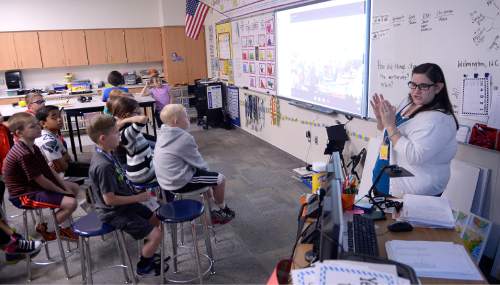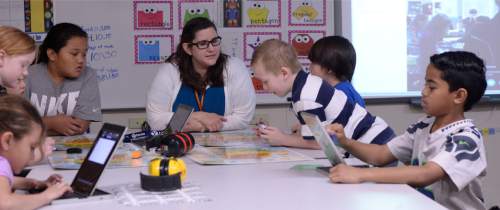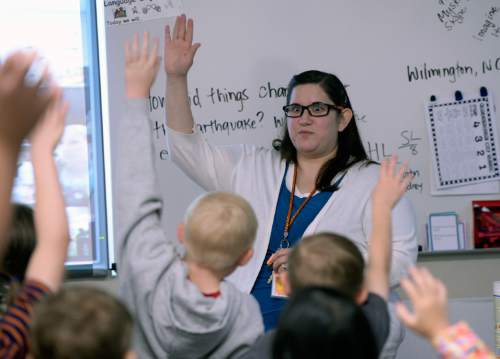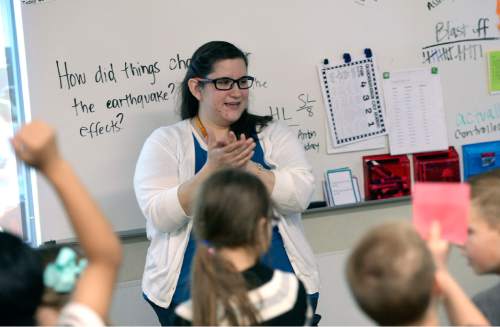This is an archived article that was published on sltrib.com in 2015, and information in the article may be outdated. It is provided only for personal research purposes and may not be reprinted.
Editor's note • This is the fifth in a five-part series about Utah educators given Teacher Innovation Awards this year for their use of technology in classrooms.
—
West Valley City • Bored, disengaged and often in trouble.
That's how Robin Farnsworth remembers her years in school, growing up in Oregon.
"I don't even remember one name of one teacher I had. I just didn't connect," says Farnsworth, now a teacher herself, and a good one at that.
She teaches third-graders at Neil Armstrong Academy — the Granite School District's STEM (science, technology, engineering and math) elementary school.
Farnsworth is one of five teachers selected for this year's Teacher Innovation Awards, sponsored by KUED and The Salt Lake Tribune.
For her, it's all about getting kids interested and actively learning.
"If I can engage a student in their learning, I've kind of invited them to the party, and then it's limitless possibilities."
That invitation is on display on a spring morning, when Farnsworth's charges have a "Mystery Skype" with a third-grade class in Wilmington, N.C.
Neither class knows where the other is, and the goal is to take turns asking questions about geography, history and culture to guess the other's location.
Farnsworth's students pore over a laminated map, marking off whole sections of the country and individual states as they rule them out.
"Do you border the Atlantic Ocean?" asks Jeffrey Badger, the boy deputized to ask the questions that his classmates composed.
"Does your state have an NFL team?" ask the North Carolina students. "Are you one of the 13 original colonies?"
Narrowing the options, the Farnsworth students ask, "Does your state start with the letter N?" followed by "Is your state North Carolina?"
After the applause dies down — the students can see one another because their Skype session is projected onto large screens — the children at Pine Valley Elementary take a bit longer to guess Utah.
Then teams in each class take turns telling about their school, the weather in their states and the geography that makes it special, including the Great Salt Lake and the lighthouse-dotted coastal plain of North Carolina.
The North Carolina pupils say they have a class guinea pig named Diego. When they Skyped with kids in Ecuador, they learned that Ecuadoreans eat guinea pigs. The Armstrong students laugh and cringe.
Such Skype sessions are fun and helpful in cementing geographic lessons, but they do two other things as well: They require students to think globally, says Farnsworth. And they demand that pupils communicate clearly, in full, grammatically correct sentences.
Farnsworth's students have participated in Squiggles of Awesome, a collaborative effort to share art with kids around the world, Pi Day, and a global read-aloud project, International Dot Day.
"I really want my students to understand that learning happens beyond the walls of our classroom, beyond the walls of our school," says Farnsworth. "And I want them to be prepared to deal with the global marketplace, because that's where we're sending them."
—
Web wonders • As a child, it never occurred to Farnsworth that she would be a teacher. The notion began to take root, though, in high school, when she worked in her school's preschool, and did a senior internship at an elementary school.
One of eight children, she married young and moved to Florida, where she and her husband started a family. After several years, the Farnsworths moved back to Oregon and then, after a year, to Utah.
When her fourth child was born, Farnsworth went to college. A quick learner attracted to the flexibility of online education, she earned a four-year degree in 18 months at Western Governors University. Then, quickly, she got her master's degree in education as well. The only thing she couldn't do online was her student teaching.
She believes that WGU helped her be more reflective and honed her skill at articulating concepts she had learned. It also cultivated resourcefulness, she says, encouraging people to connect with others.
Today, that's a hallmark of her teaching. She networks constantly with other educators on social media, is a moderator for a weekly 9 p.m. Twitter chat for Utah educators and helped found Edcamp Utah, a day full of workshops for educators each fall.
Her mentor, LuAnn Kluge, one of the three-member Great Beginnings team for the district, says that Farnsworth is an extraordinary teacher in part because it's her passion.
Other teachers might do crafts or run marathons, but Farnsworth's passions are networking about education and teaching, says Kluge, who nominated Farnsworth for the innovative-teacher award.
As Farnsworth puts it: "I'm a one-trick pony. This is my gift."
—
Pied piper • Farnsworth started her teaching career six years ago at Woodrow Wilson Elementary, a Title 1 school in South Salt Lake.
When she heard Armstrong was opening in fall 2013, she applied and enrolled her own children, including her eldest son, who has autism.
Half of Armstrong's 745 students come from throughout the district; the other half come from the neighborhood. There's a long waiting list for the STEM school.
At Armstrong, Farnsworth is a mentor for new teachers as part of the district's Great Beginnings program. Kluge often sends new teachers from throughout the district to watch Farnsworth on the job. Her classroom-management skills are excellent, Kluge says.
At Woodrow Wilson, she had half her class on yoga balls to calm the fidgety youngsters, and at Armstrong, Farnsworth ordered up tall stools and tables so her students could stand or sit as they learn and not be confined to desks.
Farnsworth is something of a pied piper, creating hilarious videos to connect with students, such as one this winter in which teachers, administrators and office staff donned costumes and danced and sang to a Taylor Swift tune, encouraging students to "rock the [standardized] test."
She also coaches "Code Club," teaching even kindergartners to write basic computer code.
Kluge says that, unlike some teachers, Farnsworth rarely has downtime when she's sitting at a desk and her students work on assignments.
"She is constant," Kluge says. "She thinks when you are at school, you need to be in the learning mode."
On the morning they Skyped with the North Carolina kids, Farnsworth's students do have some quiet, work-alone time as she focuses on a small group of other students struggling to read.
Farnsworth's students finish their spelling worksheets and then stick their noses into books, including "The Lightning Thief" and "The Lemonade Crime," their iPads set aside for the moment.
Then it's PE time in the gym with another teacher, a session in the greenhouse where the students plant peppers, tomatoes and squash, and a science class in which the students try to design earthquake-proof buildings with toothpicks and miniature marshmallows.
That's all before noon.
Farnsworth says it's not about keeping the kids busy, but learning.
"It's not an option for them to come here and not do anything."
Twitter: @KristenMoulton Teacher awards
Five Utah teachers have been selected for the 2015 Teacher Innovation Awards, which are sponsored by KUED and The Salt Lake Tribune and celebrate the creative use of technology in classrooms.
The awards are given in the categories of arts, math, language arts, science and social studies.
The five winners are being profiled in a continuing series in The Tribune and a special program airing Monday at 8 p.m. on KUED.
Previous installments featured:
Charlie Matthews, a teacher at the Park City School District Center for Advanced Professional Studies.
Brandon Engles, a sixth-grade teacher at Shelley Elementary in the Alpine School District.
Chris Humbert, a seventh-grade teacher at Kearns Junior High in Granite School District.
Wendy Frazier-Snyder, photography teacher at American Fork High.













